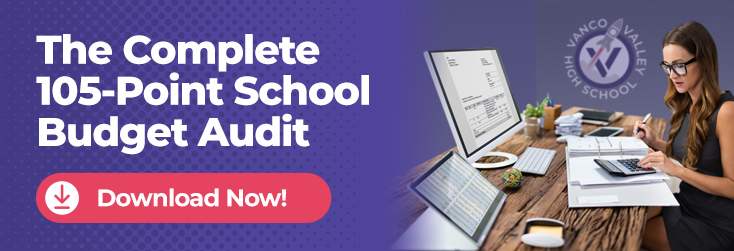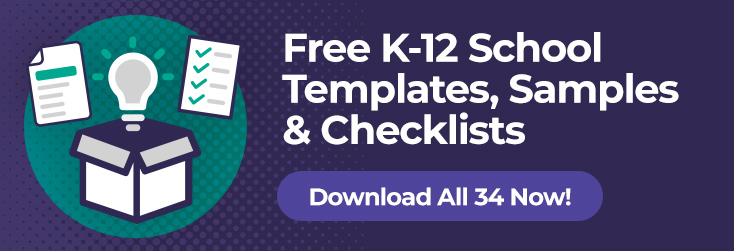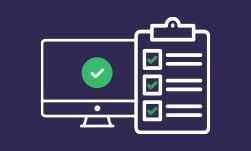 How can schools save money without sacrificing student success? It starts by rethinking the way your district operates. From cutting energy waste and reducing paper use to leveraging E‑Rate discounts and bundling procurement, schools have more control than they think. Add in regular inventory audits, and you've got a cost-saving strategy that actually works.
How can schools save money without sacrificing student success? It starts by rethinking the way your district operates. From cutting energy waste and reducing paper use to leveraging E‑Rate discounts and bundling procurement, schools have more control than they think. Add in regular inventory audits, and you've got a cost-saving strategy that actually works.
Table of Contents
- Start by Reviewing Your Budget
- Become More Energy Efficient
- Offer Flexible, Cost-Efficient Learning Formats
- Use Technology and Procurement Strategically
- Cost Saving Ideas for School Districts Include Evaluating Staffing
- Reformat Benefits Packages to Save Money
- Manage Facilities Better to Trim Costs
- Look for Ways to Cut Costs in Student Organizations and Athletics
- Understand and Reduce Transportation Costs
- Reduce Paper Usage
- Invest in Cheaper and Healthier Lunches
- Reduce Student Lunch Debt
- Get All the Must-Know School Finance Management Tips!
Start By Reviewing Your Budget
 When school funding is tight, the first step in answering how can schools save money is understanding how school budgets are determined.
When school funding is tight, the first step in answering how can schools save money is understanding how school budgets are determined.
Then you need to take a close look at your budget. Before cutting programs or staff, review where every dollar comes from—and where it goes. A smarter budget process often uncovers hidden savings without sacrificing educational quality.
Here are four school budgeting review actions that can uncover ways for schools to save money:
-
Audit Past Expenditures
Analyze spending over the past 2–3 years to identify trends and highlight areas of rapid cost growth. Flag any unused subscriptions, aging infrastructure costs, or duplicated services between schools. -
Review Contracts
Look at vendor contracts for food, transportation, and maintenance. Are you overpaying? Consider procurement bundling with neighboring districts to negotiate lower rates. -
Forecast Spending
Build flexible forecasts that account for fluctuations in state and federal funding. Use real-time financial dashboards from school finance software to spot issues before they become bigger problems. -
Compare Across Schools
Benchmark cost per student across schools in the district. Look for disparities in spending or staffing models that may signal inefficiencies. For example, you may aim for staff training cost savings by integrating AI or online programs to reduce the expense of hiring a live trainer.
Become More Energy Efficient
One of the most impactful ways to answer how schools can save money is by improving energy efficiency across facilities. According to ENERGY STAR, over 30% of energy used in K-12 schools is wasted—and low-cost improvements could reduce total consumption by approximately 10%.
Here are smart upgrades and practices to achieve substantial savings:
-
Track and audit energy use.
Use smart meters or utility dashboards to spot peak energy spikes and identify inefficient systems. -
Adjust heating and cooling schedules.
Set thermostats lower during nights, weekends, and holiday breaks. Only run HVAC systems when buildings are occupied. -
Install high-efficiency HVAC or geothermal systems.
Districts adopting geothermal heating and cooling systems—such as in New Bedford, MA—are projected to save about $300,000 annually in operating expenses. -
Upgrade insulation, roofing, and windows.
These improvements reduce air leakage and heating/cooling demand, lowering overall energy bills. -
Replace aging equipment with ENERGY STAR–rated models.
Switching to certified appliances, lighting, and vending machines delivers financial and environmental wins. -
Engage staff and students in conservation.
Encourage culture shifts like turning off lights in empty rooms and powering down electronics after use. -
Bundle contracts across the district.
Coordinate energy procurement regionally through procurement bundling to negotiate stronger utility pricing.
Need Help Becoming More Energy Efficient?
Energy Savings Comparison: Traditional HVAC vs. Geothermal and Solar
| System Type | Upfront Cost | Annual Energy Savings | ROI Timeline | Maintenance Needs |
|---|---|---|---|---|
| Traditional HVAC | $3–7 per sq ft installation | Baseline – inefficient (≈ $1.50/sq ft operating cost) | N/A | Moderate to high |
| Geothermal Heating & Cooling | Higher initial cost | Operating cost ≈ $0.70/sq ft (~50% less) | 6–10 years (New Bedford ROI example) | Low |
| High‑Efficiency HVAC (Often Paired with Solar) | Varies; influenced by rebates/incentives | 20–40% reduction in district energy costs | 5–8 years | Low |
These estimates reflect real-world school district examples and industry benchmarks—highlighting that while geothermal and solar have higher upfront costs, the long-term savings and lower maintenance make them smart investments and soften the strain on school budgets.
Offer Flexible, Cost-Efficient Learning Formats
Adopting new ways to deliver instruction can be one of the smartest cost-saving ideas for schools. Hybrid and online learning formats improve access and flexibility for students and can reduce overhead and resource costs for school districts.
Here’s how flexible learning models can help schools save:
-
Hybrid classrooms reduce facility strain.
When students alternate between in-person and remote days, schools can reduce energy use, lunch service demand, and custodial needs. -
Online platforms lower material costs.
By digitizing handouts, tests, and readings, districts reduce the need for printing, paper, and physical storage—supporting a shift toward paperless administration. -
Shared staffing models become possible.
Teachers can serve multiple classrooms or even teach virtually, helping districts cover specialty subjects or electives without hiring more full-time staff. -
Scalable tools stretch budgets.
Investing in a strong Learning Management System (LMS) or virtual instruction platform pays off long-term by centralizing delivery and making it easier to scale across grade levels. -
Potential for revenue generation.
Schools with strong online programs can extend their offerings to homeschoolers or neighboring districts for a fee—turning educational expertise into a funding stream.
Review your student attendance patterns and tech access before shifting formats. Even partial adoption of hybrid schedules can reduce costs and create scheduling flexibility.
Use Technology and Procurement Strategically
Various technologies and procurement strategies can reduce expenses. Here are some examples of how schools save money.
- E-Rate Discounts: Also known as the Schools and Libraries Program, E-Rate provides discounted telecommunication and internet access services to schools and libraries throughout the United States. Schools can apply through the Universal Service Administrative Co.
- Internet Bundling involves multiple schools grouping to procure internet services at a lower price. Statistics show that internet bundling can save schools 37%.
- Group Purchasing Tools: This strategy is similar to internet bundling but can apply to any school supply or service type. Multiple schools or institutions work together to reduce costs through collective bargaining power. Research shows that schools participating in a cooperative program can save 15% to 25%.
Cost Saving Ideas for School Districts Include Evaluating Staffing
How can schools save money? Evaluating staff can help. Schools may decide to replace workers through voluntary retirements, role reassignments, and third-party outsourcing.
While evaluating staffing needs can be a fraught process, it is important to do it if you have too many employees. On the front end, be open and transparent about your process and as gracious and thorough as possible.
Here are some ways schools can approach this sensitive topic:
Understand Whether Layoffs are Necessary
Declining revenue is the main indicator of a need for layoffs. However, other factors, like industry trends or restructuring, can also require a school to reduce staff.
Obviously, layoffs are not a preferred solution for many schools, as they can have devastating effects on workers, and many facilities have developed meaningful relationships with their staff members. However, it may be a necessary step in preventing the school from closing entirely.
Before moving forward with layoffs, explore these alternatives:
- Freeze hiring for non-essential roles
- Reduce or eliminate overtime hours
- Offer early retirement or voluntary separation incentives
- Reassign staff to open roles in other schools
- Limit or pause professional development travel
- Reduce part-time contractor or consultant use
- Consolidate roles or departments where possible
- Transition support roles to part-time where feasible
Understand what your layoff policies look like and make changes to help retain your strongest teachers. Look at performance evaluations to determine who your weakest teachers are. And gather as much information as you can before making any decisions.
And evaluate administrators, too. Could you have one principal overseeing multiple schools? Do you need as many administrators as you have in place since they earn higher salaries?
Be wary of laying off teachers. While doing so may save money, it raises doubts about the quality of your district's education. Make this a last-resort option.
Outsource Some Responsibilities
Administrators wondering how can school districts save money may turn to outsourcing. They can hire a third-party company to handle certain duties, eliminating the need to add another person to payroll and pay employer taxes. A Microsourcing article reveals companies can save up to 70% by outsourcing without sacrificing productivity.
Managed operations can handle various school tasks, including payroll, human resources, IT support, facilities management, administration, and financial aid management.
Incentivize Retirement
According to Best Colleges, experienced teachers earn 44% more than new teachers. Senior teachers can potentially be replaced at a lower pay rate when they retire. Schools may also choose not to replace teachers who retire, offering an effective solution for reducing staff without layoffs.
Retirement is typically a decision made by the employee, but schools can incentivize staff members to make the move through retirement plan matching, profit sharing, early retirement packages, and health savings accounts (HSAs).
Consider offering cash or health coverage incentives to get your older teachers to retire early. For example, San Diego offered early retirement packages to trim down costs due to huge budget shortages. According to the San Francisco Chronicle, the results were strong with 965 applications, including 478 teachers, exceeding expectations by 27%.
As was the case with San Diego, offering a reduced salary and benefits was enough to entice teachers to take the money and run. You could also establish a rewards program so that teachers who announce early retirement are awarded for doing so.
Be sure to check the legal ramifications of your actions. Discuss options with your board and financial team, too. You need to plan these offers early so that you can save money by enacting them.
Role Reassignments
An SHRM report reveals the average cost per employee hire is $4700, although many employers estimate they may spend three to four times a position's salary finding new workers. Schools and other organizations spend money on talent acquisition while sacrificing time and productivity.
Schools can reduce these costs through role reassignments, which involve internally hiring trusted employees for new roles. In some instances, employees may handle multiple responsibilities, further reducing costs.
Make Careful Decisions
School districts must make decisions grounded in data, equity, and long-term impact when considering staff reductions or benefit changes. While cutting a salary and benefits package can generate short-term savings, it may also undermine morale, public trust, and instructional quality.
National data show that, on average, most current school spending is directed to instruction and instruction-related services, with 79% of the money going towards staff salaries and benefits. If your district's spending deviates significantly, it's time to explore other options first.
When making decisions, be sure to ask yourself:
- Will this decision impact students' access to high-quality instruction?
- Is there an opportunity to reassign, automate, or outsource a role instead of cutting it?
- How will the decision be communicated to staff and community stakeholders?
- Could this move overstretch remaining employees or reduce effectiveness?
Ultimately, answering how school districts can save money requires balancing budgetary needs against instructional integrity. The real goal is long-term stability, not short-term cuts.
Reformat Benefits Packages to Save Money
With the average benefits package accounting for 30% of an employee's overall compensation, organizations like school districts pay a lot in benefits. Beyond the base salary, a district would pay an additional $15,000 for a teacher in employee healthcare costs, totaling $ $50,000.
One of the more effective cost-cutting strategies for schools is to trim benefits packages. You don't want to erase the perks of working at your district, but you can make some key adjustments. For example, you can increase deductibles in your health coverage plan to lower what you pay.
Another option involves offering additional health care coverage to retired employees who have worked for your district for a longer period. This will exclude some people from this big financial benefit, but may encourage more allegiance to your district.
Self-funded plans may also produce cost savings. With these plans, employers pay staff medical expenses directly, eliminating expensive premiums.
With so many considerations, it is helpful to use a school management system and school finance software. You can track benefits, costs and analytics related to finances and payroll. You'll be able to catch small budgetary increases before they snowball into bigger issues.
PPO vs. HSA Savings
Employers may also choose between a PPO and an HSA insurance plan. They vary as follows:
- Preferred Provider Organizations (PPOs) cover certain medical providers in a network.
- Health Savings Accounts (HSAs) are accounts you can use to pay medical expenses without deductibles or copays. The account holder deposits funds into the account before taxes, which can be withdrawn to pay for specific health expenses. They are ideal for people with high-deductible accounts.
Employers must consider which is best for their school based on the following factors:
- Employee Preferences: Employers and employees may prefer a PPO's more straightforward approach.
- Tax Advantages: Although HSAs offer direct tax deductions, employers can deduct 100% of PPO contributions.
- Cost: PPOs are generally more expensive.
- Employee Understanding: Employees may not understand HSAs, so employers may need to take time to explain what they involve.
- Limited Accessibility: Depending on income, some employees may be unable to fund their HSAs.
Manage Facilities Better to Trim Costs
Several school management techniques can help cut costs. For example, you may make the following relatively minor upgrades to significantly increase ROI:
- Install LED Lighting: According to Energy.gov, LED lights use 75% less energy than incandescent bulbs and last 25 times longer. They have higher upfront costs, but the long-term savings are worth the investment.
- Use SMART Thermostats: These thermostats can be programmed to adjust temperatures automatically. They can adapt to a comfortable temperature when students are in school, and decrease to lower temperatures or even shut off at night and during vacations.
- Schedule Regular Maintenance: Scheduled preventive maintenance can also reduce costs. Have contractors regularly check plumbing, HVAC and electrical systems and appliances. They can address issues early on before they develop into bigger problems.
Look for Ways to Cut Costs in Student Organizations and Athletics
Looking for a flexible and secure ticketing solution for school district events? Check out our Online Ticket Sales for School Districts.
Sports, arts programming and student organizations contribute significant costs to your school district. When looking into cost-cutting strategies for schools in your district, don't look away from these programs. Instead, implement tactics that can save money without eliminating offerings.
With your athletics events, establish a strong base of volunteers to help out at games. That way, you won't need to rely on hired staff. To go a step further, help start a boosters program that can generate independent funds to support your athletic programs.
Don't jump on the uniform bandwagon and upgrade uniforms each season. Stretch the time between upgrades, and only buy the equipment that is essential for a given sport. Ask students what they already own.
Charge for tickets at games and use a streamlined ticketing system powered by Vanco's school payment system for your athletic events. From basketball to baseball, you can save time and money by choosing digital payments through an online platform. You won't need to hire people to staff ticket counters or deal with the clunkiness of cash transactions.
A thriving music program is a major draw for any school district. However, you need to keep tabs on costs for trips, concerts and other school events in your music program. Consider setting up an online store to help offset costs and generate revenue.
You may also use an interdistrict loan program for supplies and materials that student organizations use. This way you won't be purchasing multiple sets of the same type of media in each school. Administrators wondering, how can schools save money may consider these methods when targeting athletics and student organizations.

Understand and Reduce Transportation Costs
If you're living in a district with busing, then you know that fuel costs can add up quickly. Transportation costs can gouge a district budget. And with fluctuating oil prices, it's difficult to know how much you should set aside in your budget for travel.
Busing costs vary by location, and each school has unique needs, but prices can be pretty substantial. For example, the Milburn Board of Education projected a cost of $1,368,990 for the 2025/2026 school year. Schools may charge parents for this service, or receive government funding, but they may also be required to compensate for shortages.
Schools can reduce transportation costs through the following methods:
- Route optimization: When picking up and dropping off students, plan a route that won't take the driver out of their way to minimize gas use and related expenses. Various apps can aid with this goal.
- Shared Services: This option involves multiple school districts consolidating buses, drivers and routes to lower costs.
- Use Volunteers: Consider using skilled volunteer parents and community members as your bus drivers and monitors to save on wages.
Reduce Paper Usage
 When you think of schools, you probably think of stacks of paper in classrooms and offices. Paper products are necessary in any school setting, but can also be expensive. Fortunately, there are several ways for schools to save money in this category.
When you think of schools, you probably think of stacks of paper in classrooms and offices. Paper products are necessary in any school setting, but can also be expensive. Fortunately, there are several ways for schools to save money in this category.
Gather information on how often departments use paper products. Could these documents be shared just as easily online? If so, find ways to go paperless with department reports — and cinch in the expense limits for copies in each department.
Here are some suggestions:
- Eliminate forms requiring supervisor signatures to save on paper and reduce red tape.
- Ask your employees to bring laptops and tablets to meetings rather than printouts of necessary documents.
- Restrict printing access at the school so only essential items are printed.
- Send attachments via email rather than cross-campus mail.
- Set up an online student-parent portal to avoid mailing grades and other notices.
- Communicate with parents your rationale for eliminating paper waste in the district so they can help.
- Aim to go paperless with tasks such as class registration, job applications, and checking requisitions. Make it easy for applicants to apply for positions through an online portal.
- Let guidance counselors work with students to complete class registration and provide access to grades online.
Invest in Cheaper and Healthier Lunches
School lunches are another source of spending. An Education Data report reveals that a school lunch costs $2.99, while breakfast costs $1.77. These prices may seem relatively low, but they can add up over time.
USDA programs help schools save money. They provide billions of dollars in financial support to schools through various programs, such as:
- The National School Lunch Program: This federally funded program offers nutritious, low-cost, or free meals to students in public and private schools.
- School Breakfast Program: This program provides free or low-cost breakfast to children in over 90,000 schools nationwide.
- The Summer Food Service Program provides meals to children in low-income areas during the summer when schools are typically closed.
Schools may also adjust their menus to swap out unhealthy foods with nutritious options without spending a lot more money. For example, fresh fruits and vegetables may be less expensive than pizza. Healthy meals also lead to better academic performance and lower childhood obesity.
Contrary to common perceptions, schools serving healthier lunches are doing as well, if not better, than those serving standard lunches. The healthier lunches, which are loaded with vegetables and whole grains, are an attractive option in a country with an obesity epidemic. In fact, some districts are even seeing a profit after making significant changes to their school lunch offerings.
Reduce Student Lunch Debt
The average school is shouldering thousands of dollars in lunch debt and that debt is expected to grow each year. Some districts are turning to donations and crowdfunding to get the money they need. Vanco can help. We built free school fundraising letter templates to help you create donation request messages so you can raise money with less hassle.
You can also save money and improve students' lunchtime experience by using an online system to manage school lunch payments. Simplifying school lunch payments gives students an easy way to pay for their meals through an online system — and you'll help them get their food faster.
Get All the Must-Know School Finance Management Tips!
You can download the complete school finance guide for free. It offers the strategies schools need to keep a healthy budget and practical tools to cut costs without sacrificing student success.
FAQs
How can schools save money through energy upgrades?
Energy upgrades save schools money on energy bills. Effective strategies include:
- Replacing incandescent lights with LED bulbs
- Using automated systems to avoid wasting energy
- Conduct an energy audit to identify areas of waste
What’s the fastest way for schools to reduce expenses?
It is difficult to pinpoint the fastest ways for schools to reduce expenses, as each facility differs. However, here are some ideas:
- Make energy-efficient upgrades
- Go digital
- Increase automation
Can schools cut costs without cutting staff?
Yes, schools can cut costs without cutting staff. For example, energy-efficient updates and going digital can save money and allow schools to retain valuable staff members. However, if payroll is an issue, there may be no other solution.
What grants or programs help schools save money?
Various grants and programs help schools save money. For example, schools may:
- Look into USDA programs that help them reduce school meal expenses
- Consider local and federal grants
- Enter into collective purchasing organizations to save money on supplies and technology
How Can Schools Earn Extra Money?
Schools can earn extra money with the following strategies:
- Facility Rental: Rent the facility out for events or rent parking spaces
- Fundraising: Bake sales, car washes and branded merchandise help schools make money
- Partnerships and Sponsorships: Partner with local businesses on affiliate programs, exclusivity agreements and advertising to generate income










.jpg?width=734&height=251&name=School-Lunch-Kit_blog_CTA_image%20(1).jpg)









